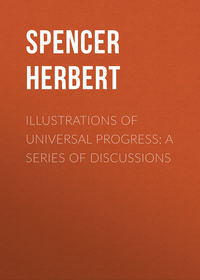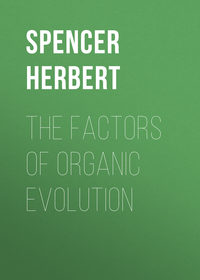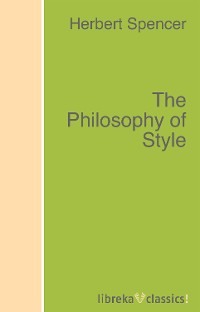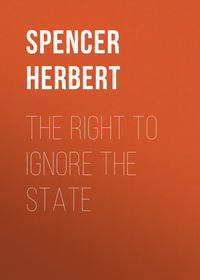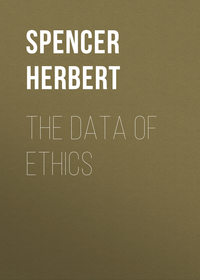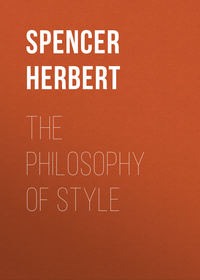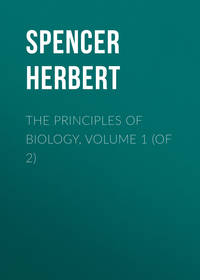 полная версия
полная версияFirst Principles
Moreover, it must not be forgotten that though the evidence suffices neither for proof nor disproof, yet some of its most conspicuous facts support the belief, that the more heterogeneous organisms and groups of organisms, have been evolved from the less heterogeneous ones. The average community of type between the fossils of adjacent strata, and still more the community that is found between the latest tertiary fossils and creatures now existing, is one of these facts. The discovery in some modern deposits of such forms as the Palæotherium and Anaplotherium, which, if we may rely on Prof. Owen, had a type of structure intermediate between some of the types now existing, is another of these facts. And the comparatively recent appearance of Man, is a third fact of this kind, which possesses still greater significance. Hence we may say, that though our knowledge of past life upon the Earth, is too scanty to justify us in asserting an evolution of the simple into the complex, either in individual forms or in the aggregate of forms; yet the knowledge we have, not only consists with the belief that there has been such an evolution, but rather supports it than otherwise.
§ 47. Whether an advance from the homogeneous to the heterogeneous is or is not displayed in the biological history of the globe, it is clearly enough displayed in the progress of the latest and most heterogeneous creature – Man. It is alike true that, during the period in which the Earth has been peopled, the human organism has grown more heterogeneous among the civilized divisions of the species; and that the species, as a whole, has been made more heterogeneous by the multiplication of races and the differentiation of these races from each other. In proof of the first of these positions, we may cite the fact that, in the relative development of the limbs, the civilized man departs more widely from the general type of the placental mammalia, than do the lower human races. Though often possessing well-developed body and arms, the Papuan has extremely small legs: thus reminding us of the quadrumana, in which there is no great contrast in size between the hind and fore limbs. But in the European, the greater length and massiveness of the legs has become very marked – the fore and hind limbs are relatively more heterogeneous. Again, the greater ratio which the cranial bones bear to the facial bones, illustrates the same truth. Among the vertebrata in general, evolution is marked by an increasing heterogeneity in the vertebral column, and more especially in the segments constituting the skull: the higher forms being distinguished by the relatively larger size of the bones which cover the brain, and the relatively smaller size of those which form the jaws, &c. Now, this characteristic, which is stronger in Man than in any other creature, is stronger in the European than in the savage. Moreover, judging from the greater extent and variety of faculty he exhibits, we may infer that the civilized man has also a more complex or heterogeneous nervous system than the uncivilized man; and indeed the fact is in part visible in the increased ratio which his cerebrum bears to the subjacent ganglia. If further elucidation be needed, we may find it in every nursery. The infant European has sundry marked points of resemblance to the lower human races; as in the flatness of the alæ of the nose, the depression of its bridge, the divergence and forward opening of the nostrils, the form of the lips, the absence of a frontal sinus, the width between the eyes, the smallness of the legs. Now, as the developmental process by which these traits are turned into those of the adult European, is a continuation of that change from the homogeneous to the heterogeneous displayed during the previous evolution of the embryo, which every physiologist will admit; it follows that the parallel developmental process by which the like traits of the barbarous races have been turned into those of the civilized races, has also been a continuation of the change from the homogeneous to the heterogeneous. The truth of the second position – that Mankind, as a whole, have become more heterogeneous – is so obvious as scarcely to need illustration. Every work on Ethnology, by its divisions and subdivisions of races, bears testimony to it. Even were we to admit the hypothesis that Mankind originated from several separate stocks, it would still remain true that as, from each of these stocks, there have sprung many now widely different tribes, which are proved by philological evidence to have had a common origin, the race as a whole is far less homogeneous than it once was. Add to which, that we have, in the Anglo-Americans, an example of a new variety arising within these few generations; and that, if we may trust to the descriptions of observers, we are likely soon to have another such example in Australia.
§ 48. On passing from Humanity under its individual form, to Humanity as socially embodied, we find the general law still more variously exemplified. The change from the homogeneous to the heterogeneous, is displayed equally in the progress of civilization as a whole, and in the progress of every tribe or nation; and is still going on with increasing rapidity.
As we see in existing barbarous tribes, society in its first and lowest form is a homogeneous aggregation of individuals having like powers and like functions: the only marked difference of function being that which accompanies difference of sex. Every man is warrior, hunter, fisherman, tool-maker, builder; every woman performs the same drudgeries; every family is self-sufficing, and, save for purposes of aggression and defence, might as well live apart from the rest. Very early, however, in the process of social evolution, we find an incipient differentiation between the governing and the governed. Some kind of chieftainship seems coeval with the first advance from the state of separate wandering families to that of a nomadic tribe. The authority of the strongest makes itself felt among a body of savages, as in a herd of animals, or a posse of school-boys. At first, however, it is indefinite, uncertain; is shared by others of scarcely inferior power; and is unaccompanied by any difference in occupation or style of living: the first ruler kills his own game, makes his own weapons, builds his own hut, and, economically considered, does not differ from others of his tribe. Gradually, as the tribe progresses, the contrast between the governing and the governed grows more decided. Supreme power becomes hereditary in one family; the head of that family, ceasing to provide for his own wants, is served by others; and he begins to assume the sole office of ruling. At the same time there has been arising a co-ordinate species of government – that of Religion. As all ancient records and traditions prove, the earliest rulers are regarded as divine personages. The maxims and commands they uttered during their lives are held sacred after their deaths, and are enforced by their divinely-descended successors; who in their turns are promoted to the pantheon of the race, there to be worshipped and propitiated along with their predecessors: the most ancient of whom is the supreme god, and the rest subordinate gods. For a long time these connate forms of government – civil and religious – continue closely associated. For many generations the king continues to be the chief priest, and the priesthood to be members of the royal race. For many ages religious law continues to contain more or less of civil regulation, and civil law to possess more or less of religious sanction; and even among the most advanced nations these two controlling agencies are by no means completely differentiated from each other. Having a common root with these, and gradually diverging from them, we find yet another controlling agency – that of Manners or ceremonial usages. All titles of honour are originally the names of the god-king; afterwards of God and the king; still later of persons of high rank; and finally come, some of them, to be used between man and man. All forms of complimentary address were at first the expressions of submission from prisoners to their conqueror, or from subjects to their ruler, either human or divine – expressions that were afterwards used to propitiate subordinate authorities, and slowly descended into ordinary intercourse. All modes of salutation were once obeisances made before the monarch and used in worship of him after his death. Presently others of the god-descended race were similarly saluted; and by degrees some of the salutations have become the due of all.9 Thus, no sooner does the originally homogeneous social mass differentiate into the governed and the governing parts, than this last exhibits an incipient differentiation into religious and secular – Church and State; while at the same time there begins to be differentiated from both, that less definite species of government which rides our daily intercourse – a species of government which, as we may see in heralds’ colleges, in books of the peerage, in masters of ceremonies, is not without a certain embodiment of its own. Each of these kinds of government is itself subject to successive differentiations. In the course of ages, there arises, as among ourselves, a highly complex political organization of monarch, ministers, lords and commons, with their subordinate administrative departments, courts of justice, revenue offices, &c., supplemented in the provinces by municipal governments, county governments, parish or union governments – all of them more or less elaborated. By its side there grows up a highly complex religious organization, with its various grades of officials from archbishops down to sextons, its colleges, convocations, ecclesiastical courts, &c.; to all which must be added the ever-multiplying independent sects, each with its general and local authorities. And at the same time there is developed a highly complex aggregation of customs, manners, and temporary fashions, enforced by society at large, and serving to control those minor transactions between man and man which are not regulated by civil and religious law. Moreover, it is to be observed that this ever-increasing heterogeneity in the governmental appliances of each nation, has been accompanied by an increasing heterogeneity in the governmental appliances of different nations: all of which are more or less unlike in their political systems and legislation, in their creeds and religious institutions, in their customs and ceremonial usages.
Simultaneously there has been going on a second differentiation of a more familiar kind; that, namely, by which the mass of the community has been segregated into distinct classes and orders of workers. While the governing part has undergone the complex development above detailed, the governed part has undergone an equally complex development; which has resulted in that minute division of labour characterizing advanced nations. It is needless to trace out this progress from its first stages, up through the caste divisions of the East and the incorporated guilds of Europe, to the elaborate producing and distributing organization existing among ourselves. Political economists have long since indicated the evolution which, beginning with a tribe whose members severally perform the same actions, each for himself ends with a civilized community whose members severally perform different actions for each other; and they have further pointed out the changes through which the solitary producer of any one commodity, is transformed into a combination of producers who, united under a master, take separate parts in the manufacture of such commodity. But there are yet other and higher phases of this advance from the homogeneous to the heterogeneous in the industrial organization of society. Long after considerable progress has been made in the division of labour among the different classes of workers, there is still little or no division of labour among the widely separated parts of the community: the nation continues comparatively homogeneous in the respect that in each district the same occupations are pursued. But when roads and other means of transit become numerous and good, the different districts begin to assume different functions, and to become mutually dependent. The calico-manufacture locates itself in this county, the woollen-manufacture in that; silks are produced here, lace there; stockings in one place, shoes in another; pottery, hardware, cutlery, come to have their special towns; and ultimately every locality grows more or less distinguished from the rest by the leading occupation carried on in it. Nay, more, this subdivision of functions shows itself not only among the different parts of the same nation, but among different nations. That exchange of commodities which free-trade promises so greatly to increase, will ultimately have the effect of specializing, in a greater or less degree, the industry of each people. So that beginning with a barbarous tribe, almost if not quite homogeneous in the functions of its members, the progress has been, and still is, towards an economic aggregation of the whole human race; growing ever more heterogeneous in respect of the separate functions assumed by separate nations, the separate functions assumed by the local sections of each nation, the separate functions assumed by the many kinds of makers and traders in each town, and the separate functions assumed by the workers united in producing each commodity.
§ 49. Not only is the law thus clearly exemplified in the evolution of the social organism, but it is exemplified with equal clearness in the evolution of all products of human thought and action; whether concrete or abstract, real or ideal. Let us take Language as our first illustration.
The lowest form of language is the exclamation, by which an entire idea is vaguely conveyed through a single sound; as among the lower animals. That human language ever consisted solely of exclamations, and so was strictly homogeneous in respect of its parts of speech, we have no evidence. But that language can be traced down to a form in which nouns and verbs are its only elements, is an established fact. In the gradual multiplication of parts of speech out of these primary ones – in the differentiation of verbs into active and passive, of nouns into abstract and concrete – in the rise of distinctions of mood, tense, person, of number and case – in the formation of auxiliary verbs, of adjectives, adverbs, pronouns, prepositions, articles – in the divergence of those orders, genera, species, and varieties of parts of speech by which civilized races express minute modifications of meaning – we see a change from the homogeneous to the heterogeneous. And it may be remarked, in passing, that it is more especially in virtue of having carried this subdivision of functions to a greater extent and completeness, that the English language is superior to all others. Another aspect under which we may trace the development of language, is the differentiation of words of allied meanings. Philology early disclosed the truth that in all languages words may be grouped into families having a common ancestry. An aboriginal name, applied indiscriminately to each of an extensive and ill-defined class of things or actions, presently undergoes modifications by which the chief divisions of the class are expressed. These several names springing from the primitive root, themselves become the parents of other names still further modified. And by the aid of those systematic modes which presently arise, of making derivatives and forming compound terms expressing still smaller distinctions, there is finally developed a tribe of words so heterogeneous in sound and meaning, that to the uninitiated it seems incredible they should have had a common origin. Meanwhile, from other roots there are being evolved other such tribes, until there results a language of some sixty thousand or more unlike words, signifying as many unlike objects, qualities, acts. Yet another way in which language in general advances from the homogeneous to the heterogeneous, is in the multiplication of languages. Whether, as Max Müller and Bunsen think, all languages have grown from one stock, or whether, as some philologists say, they have grown from two or more stocks, it is clear that since large families of languages, as the Indo-European, are of one parentage, they have become distinct through a process of continuous divergence. The same diffusion over the Earth’s surface which has led to the differentiation of the race, has simultaneously led to a differentiation of their speech: a truth which we see further illustrated in each nation by the peculiarities of dialect found in separate districts. Thus the progress of Language conforms to the general law, alike in the evolution of languages, in the evolution of families of words, and in the evolution of parts of speech.
On passing from spoken to written language, we come upon several classes of facts, all having similar implications. Written language is connate with Painting and Sculpture; and at first all three are appendages of Architecture, and have a direct connexion with the primary form of all Government – the theocratic. Merely noting by the way the fact that sundry wild races, as for example the Australians and the tribes of South Africa, are given to depicting personages and events upon the walls of caves, which are probably regarded as sacred places, let us pass to the case of the Egyptians. Among them, as also among the Assyrians, we find mural paintings used to decorate the temple of the god and the palace of the king (which were, indeed, originally identical); and as such they were governmental appliances in the same sense that state-pageants and religious feasts were. Further, they were governmental appliances in virtue of representing the worship of the god, the triumphs of the god-king, the submission of his subjects, and the punishment of the rebellious. And yet again they were governmental, as being the products of an art reverenced by the people as a sacred mystery. From the habitual use of this pictorial representation, there naturally grew up the but slightly-modified practice of picture-writing – a practice which was found still extant among the Mexicans at the time they were discovered. By abbreviations analogous to those still going on in our own written and spoken language, the most familiar of these pictured figures were successively simplified; and ultimately there grew up a system of symbols, most of which had but a distant resemblance to the things for which they stood. The inference that the hieroglyphics of the Egyptians were thus produced, is confirmed by the fact that the picture-writing of the Mexicans was found to have given birth to a like family of ideographic forms; and among them, as among the Egyptians, these had been partially differentiated into the kuriological or imitative, and the tropical or symbolic: which were, however, used together in the same record. In Egypt, written language underwent a further differentiation; whence resulted the hieratic and the epistolographic or enchorial: both of which are derived from the original hieroglyphic. At the same time we find that for the expression of proper names, which could not be otherwise conveyed, phonetic symbols were employed; and though it is alleged that the Egyptians never actually achieved complete alphabetic writing, yet it can scarcely be doubted that these phonetic symbols occasionally used in aid of their ideographic ones, were the germs out of which alphabetic writing grew. Once having become separate from hieroglyphics, alphabetic writing itself underwent numerous differentiations – multiplied alphabets were produced: between most of which, however, more or less connexion can still be traced. And in each civilized nation there has now grown up, for the representation of one set of sounds, several sets of written signs, used for distinct purposes. Finally, through a yet more important differentiation came printing; which, uniform in kind as it was at first, has since become multiform.
§ 50. While written language was passing through its earlier stages of development, the mural decoration which formed its root was being differentiated into Painting and Sculpture. The gods, kings, men, and animals represented, were originally marked by indented outlines and coloured. In most cases these outlines were of such depth, and the object they circumscribed so far rounded and marked out in its leading parts, as to form a species of work intermediate between intaglio and bas-relief. In other cases we see an advance upon this: the raised spaces between the figures being chiselled off, and the figures themselves appropriately tinted, a painted bas-relief was produced. The restored Assyrian architecture at Sydenham, exhibits this style of art carried to greater perfection – the persons and things represented, though still barbarously coloured, are carved out with more truth and in greater detail; and in the winged lions and bulls used for the angles of gateways, we may see a considerable advance towards a completely sculptured figure; which, nevertheless, is still coloured, and still forms part of the building. But while in Assyria the production of a statue proper, seems to have been little, if at all, attempted, we may trace in Egyptian art the gradual separation of the sculptured figure from the wall. A walk through the collection in the British Museum will clearly show this; while it will at the same time afford an opportunity of observing the evident traces which the independent statues bear of their derivation from bas-relief: seeing that nearly all of them not only display that union of the limbs with the body which is the characteristic of bas-relief, but have the back of the statue united from head to foot with a block which stands in place of the original wall. Greece repeated the leading stages of this progress. As in Egypt and Assyria, these twin arts were at first united with each other and with their parent, Architecture; and were the aids of Religion and Government. On the friezes of Greek temples, we see coloured bas-reliefs representing sacrifices, battles, processions, games – all in some sort religious. On the pediments we see painted sculptures more or less united with the tympanum, and having for subjects the triumphs of gods or heroes. Even when we come to statues that are definitely separated from the buildings to which they pertain, we still find them coloured; and only in the later periods of Greek civilization, does the differentiation of sculpture from painting appear to have become complete. In Christian art we may clearly trace a parallel re-genesis. All early paintings and sculptures throughout Europe, were religious in subject – represented Christs, crucifixions, virgins, holy families, apostles, saints. They formed integral parts of church architecture, and were among the means of exciting worship: as in Roman Catholic countries they still are. Moreover, the early sculptures of Christ on the cross, of virgins, of saints, were coloured; and it needs but to call to mind the painted madonnas and crucifixes still abundant in continental churches and highways, to perceive the significant fact that painting and sculpture continue in closest connexion with each other, where they continue in closest connexion with their parent. Even when Christian sculpture was pretty clearly differentiated from painting, it was still religious and governmental in its subjects – was used for tombs in churches and statues of kings; while, at the same time, painting, where not purely ecclesiastical, was applied to the decoration of palaces, and besides representing royal personages, was almost wholly devoted to sacred legends. Only in quite recent times have painting and sculpture become entirely secular arts. Only within these few centuries has painting been divided into historical, landscape, marine, architectural, genre, animal, still-life, &c., and sculpture grown heterogeneous in respect of the variety of real and ideal subjects with which it occupies itself.
Strange as it seems then, we find it no less true, that all forms of written language, of painting, and of sculpture, have a common root in the politico-religious decorations of ancient temples and palaces. Little resemblance as they now have, the bust that stands on the console, the landscape that hangs against the wall, and the copy of the Times lying upon the table, are remotely akin; not only in nature, but by extraction. The brazen face of the knocker which the postman has just lifted, is related not only to the woodcuts of the Illustrated London News which he is delivering, but to the characters of the billet-doux which accompanies it. Between the painted window, the prayer-book on which its light falls, and the adjacent monument, there is consanguinity. The effigies on our coins, the signs over shops, the figures that fill every ledger, the coat of arms outside the carriage-panel, and the placards inside the omnibus, are, in common with dolls, blue-books and paper-hangings, lineally descended from the rude sculpture-paintings in which the Egyptians represented the triumphs and worship of their god-kings. Perhaps no example can be given which more vividly illustrates the multiplicity and heterogeneity of the products that in course of time may arise by successive differentiations from a common stock.





